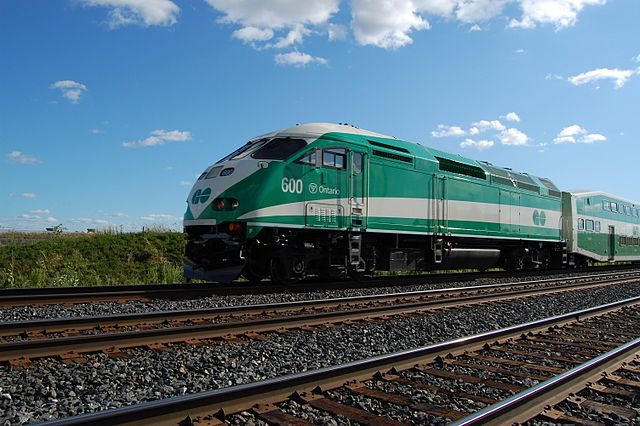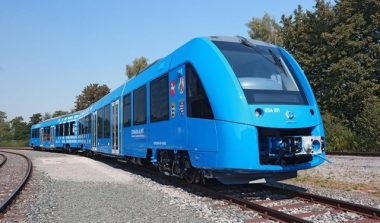
Ontario looking at hydrogen fuel cells to electrify Toronto’s GO rail network
by David Kennedy, Associate Editor

Hydrogen-powered trains would eliminate the need for costly overhead wires and could take advantage of the province's surplus of clean power it currently exports to the U.S.

The feasibility study is part of a $21.3 billion project to convert the commuter-focused GO Transit network into a regional rapid transit system. PHOTO: Milan Suvajac/Wikimedia Commons
TORONTO—The Ontario government is looking into using hydrogen-powered trains to replace the diesel locomotives that currently ferry commuters across the Greater Toronto Area.
The province’s Transportation Minister, Steven Del Duca, was at GO Transit’s Willowbrook yard in Etobicoke June 15 to kick off the environmental assessment process for the major infrastructure project.
“Electrification is an important step forward for regional rail in Ontario,” Del Duca said. “It is critical that we get it right.”
The push to electrify the Toronto area rail system is part of a $21.3 billion project Queen’s Park says will convert the commuter-focused GO Transit network into a regional rapid transit system. Trains will run more frequently both in and out of Toronto—and they’re expected to do so on electrical power as the province pares down on greenhouse gas emissions and noxious diesel fumes damaging to human health.
While traditional electric trains use overhead wires—also known as catenaries—to draw energy directly from the power grid, Del Duca said Ontario’s feasibility study will also look at using hydrogen fuel cells to fulfill the longtime promise of powering GO locomotives with electricity.
“Recent advances in hydrogen fuel cell technology being piloted on rail networks in other jurisdictions provide a possible alternative to traditional network electrification, and that’s important for us to explore,” he said. “We want to know if hydrogen fuel cell technology can be ready in time to deliver GO regional express rail by 2024-25.”

The French train maker’s hydrogen-powered Coradia iLint is expected to start carrying passengers next year. PHOTO: Alstom
These “advances” are currently taking to the rails in Europe.
France-based manufacturer Alstom has been testing a new fuel cell-powered train in Germany and the Czech Republic since March and plans to start using it to carry passengers next year. It emits just steam and condensed water and can carry 300 passengers at speeds of up to 140 km/h.
The Coradia iLint incorporates fuel cells made by Mississauga, Ont.’s Hydrogenics Corp. as its main source of power and also has on-board lithium-ion batteries to store energy that isn’t immediately put to use.
Daryl Wilson, Hydrogenics’ president and CEO, said the iLint has met all its performance targets ahead of schedule and he’s confident fuel cell-powered trains would perform well in Ontario as well.
“[They] eliminate the need for the overhead catenary wire system, or the big extension cord in the sky, as I like to call it,” he said in an interview. “This completely eliminates a large proportion of infrastructure costs associated with rail electrification.”
By taking a significant portion of the upfront costs out of the equation, Wilson says hydrogen trains are actually cheaper across their entire life-cycle than their wired counterparts.
Meanwhile, the technology would also jive with Ontario’s relatively clean electricity grid and make use of surplus power it currently exports to the U.S.
“Each year we’re still giving a lot of energy away to the U.S. for free,” Wilson said. “We believe that that surplus electrical energy could easily be turned into hydrogen gas and put on the trains as a fuel.”
Today, most hydrogen gas is produced using a process known as natural gas reforming, which generates GHG emissions. Taking advantage of surplus renewable energy to split water through electrolysis would work around this problem and make the hydrogen fuel entirely emissions-free. Along with research aimed at improving fuel cells, a number of companies and academics are also working to make electrolysis more efficient.
“Ontario has a very unique opportunity to capitalize on the surpluses of renewable energy that we have from hydro, nuclear and wind and make fuel on our own territory with our own domestic sources of energy and eliminate fossil fuels,” Wilson said.
Nevertheless, like with any novel technology, certain obstacles could complicate rolling out hydrogen-powered trains in Ontario—especially when the relatively new technology is competing with well-established wired electric rails.
The Ontario government plans to bring together a number of hydrogen industry leaders to study the technology’s potential this fall.
—With a file from The Canadian Press